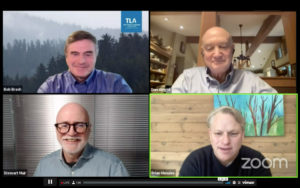
Bob Brash, Don Wright, Stewart Muir, Brian Menzies
The final Truck Loggers Association panel on modernizing BC’s forest policy was led-off by Stewart Muir, executive director of Resource Works. “At stake,” according to Muir, “is retaining the significant role the forest industry plays in BC’s economy but also the huge potential of the forest bioeconomy to be part of BC’s clean energy transformation and emissions reduction efforts—via carbon capture technology, wood pellets and forest management for carbon sequestration.”
In describing the origin of the technical panel that recommended the old growth deferrals, Muir referenced his recent article in TruckLoggerBC magazine titled, Modernization, Meet Paradigm shift. Paradigm Shift, Meet Chaos. An article informed by a Freedom of Information request of internal government correspondence. The key findings being that:
- The forest industry was little involved
- An external party (the Sierra Club) defined the public process to a great degree and the composition of the committee (civil service experts were excluded)
- The barometer of success was defined as positive media coverage towards quick action.
As for the secret to ENGO success, Muir noted the effectiveness of their “hybrid advocacy strategy”, which involves indirect pressure from negative messaging (e.g., via media-friendly stunts at the Fairy Creek protests) and direct pressure on government officials (via lobby efforts described by one ENGO as “bombarding government decision makers”). Muir concluded with his suggestions to industry:
- Adopt the ENGO hybrid advocacy technique (mobilize supporters, be competitive)
- Recognize changes in media (where reporters have limited time to investigate)
- Act quickly and firmly to correct misinformation
- Look for ways to be (and be seen as) constructive change leaders.
Next up was Brian Menzies, executive director of the Independent Wood Processors Association of BC, who characterized his membership as “value-added wood product creators and innovators.” And for context and emphasis, added that “the majority of whom are urban-based companies that operate without tenure or fibre security”. According to Menzies, it was Premier Horgan’s stated vision of a forest industry that focuses more on high-value rather than high-volume manufacturing—that spurred his organization to engage supportively and “propose policy that pushed in the direction of more diversification.”
“And then all of sudden this happened” exclaimed Menzies, referring to the Minister’s announcement in the House “that 2.6 million hectares [of old growth] potentially could be deferred… and if every area was to be deferred, we would expect about 4,500 jobs would be lost”. But what scares Menzies the most is that these so-called “potential deferrals” are impacting his members now, and supply is running out”. This is because more than 50% of their fibre input is from old growth forests, the major licensees are understandably more cautious with their fibre and the BC Timber Sales program immediately stopped any related-area timber sales. “We’re talking months before businesses start shutting down, not years from now when the Chief Forester recalculates the AAC”. Further, Menzies said, it’s not a question of converting his industry to second-growth wood, because “old growth fibre produces different products, products that can’t be produced from second growth. …And our customers won’t wait, they will start looking at alterative products that are not at all carbon friendly like wood”. To be heard, Menzies offered up his “do-it-yourself” media campaign called ForestryforBC.ca.
Finally, Don Wright, former Deputy Minister for Premier Horgan, said he believes the old growth and other policy changes occurred because “the forest industry has lost its social licence by not effectively making the case that it is essential to BC prosperity”. The reasons he cited being:
- BC’s rapidly growing pollution in urban areas means a reduced % of the population is connected to the forest industry and understands its importance
- Consolidation and investments outside BC have reduced the number and diversity of industry players, lessening their focus on BC (and the support they can count on from workers, communities, contractors and the value-added sector)
- Underdeveloped partnerships with First Nations—industry has been too timid and too slow
- Public complacency about the strength of the economy—the growing sense that BC doesn’t need the resource industries any more.
According to Wright, BC is currently spending $25 billion more than it earns, financed by “selling off the right to reside in BC”. The monies from the outside being brought in by real estate purchases and related consumption from income earned elsewhere. “But this is living in a fool’s paradise,” according to Wright, “as it’s not sustainable”. It’s also where the forest industry has an opportunity to rebuild its social licence. “This is because the standard of living in a jurisdiction comes from the wages and net government revenue that its tradeable goods and services sector can afford to pay. And in Canada this is largely its natural resource-based industries. In BC, forestry represents 18% of this base and the film, high tech and tourism industries simply can’t replace them without a significant reduction in our standard of living.”
In closing, Wright said “it would be a tragedy if the forest industry is not able to re-establish its social licence.” And to do this, he recommends the sector pull together to “make the argument of the significant value of the resource industry to the BC economy and BC standard of living. Government responds to the chatter they hear and they are hearing a lot more from the ENGO crowd than those who want to maintain a strong economy.”